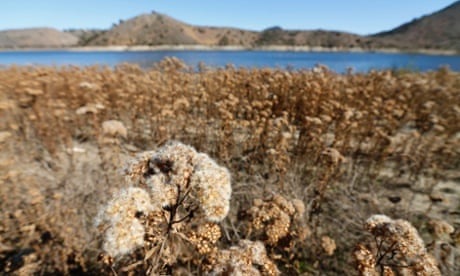As weather reports suggest some light relief for California from the record-breaking drought that's hit the state, it's largely business as usual for Silicon Valley tech giants like Adobe, eBay, Google and the solar panel manufacturer SunPower. That's because those companies have long made water conservation part of their sustainability initiatives.
"Since we know we have more people using facilities like showers and washing machines than most corporate campuses, we've always been aware that we have the unique opportunity – and responsibility – to help them do so with as little waste as possible," says Anthony Ravitz, the green team lead for Google's real estate and workplace services.
Even so, sustainability managers are stepping efforts to curtail water consumption through technological innovation as California Governor Jerry Brown calls for a voluntary 20% cut in water use statewide. (Google and eBay are also creating internal websites and other programs to show employees how to save water at home.)
The severity of the water drought – some scientists believe it's the worst in 500 years – was underscored by a report issued this month by the US National Oceanic and Atmospheric Administration, which found that 94.2% of the state face water shortages. The report noted that 2013 was the driest year in California's recorded history and January 2014 , normally one of the wettest months, was the third driest January. Farmers who depend on two massive water projects to irrigate their crops will not receive a drop of water this year.
Adobe spokeswoman Colleen Rodriguez says it has cut water consumption in its San Francisco Bay Area buildings by 62% since 2000 by installing low-flow faucets, waterless urinals and using drought-resistant native plants and drip-irrigation systems. But in the wake of the drought, the company that makes the ubiquitous Flash media player, has switched off fountains at its San Jose headquarters that taps recycled groundwater. Instead that water will now improve flows to the nearby Guadalupe River.
That's the low-hanging fruit, though. To adapt to what may become permanent drought conditions, tech companies are looking beyond fixes like low-flow faucets to strategies that could serve as a model for companies around the world.
For example, a big water hog is air-conditioning systems used in offices and data centers. An eBay spokeswoman, Kari Ramirez, says data centers are the company's biggest water users so efforts are underway to cut consumption by installing fans among the rows of computer servers while switching to passive cooling systems. Adobe, meanwhile, is exploring how to change its climate control systems to use recycled water for cooling.
"Additionally, we are looking at ways to recapture rain water, reclaim our own waste water, and use recycled water (if available) from the cities where we have operations," Adobe said in a statement Rodriguez gave to the Guardian.
Google's Ravitz says the search giant is considering stalling new technology such as urinal cakes that contain enzymes that calcify urine so that toilets only have to be flushed a few times a day for cleaning. That move could save an estimated 500,000 gallons of water a year, he says.
The company also is looking at how to slash water used to keep lush the landscaping at its sprawling corporate campuses. Google is considering "hydrozoning" – grouping plants with similar water needs together as well as installing sensors to monitor irrigation use and detect leaks. Last year, the company started using recycled water on part of its Mountain View landscaping, saving 9m gallons of water and will expand the program this year. EBay already displays smart irrigation systems that respond to changes in the weather.
Water consumption by solar power plants built in the desert Southwest of the US has been a hot-button issue in recent years. That led SunPower to turn to robots to minimize the water used to clean hundreds of thousands of solar panels installed at the photovoltaic power plants it develops. In November, SunPower acquired Greenbotics, a company that makes Roomba-like robots that glide over solar panels at night, cleaning as they go. The system has cut water consumption at one California photovoltaic power plant by 90%, according to SunPower spokeswoman Helen Kendrick.
She said SunPower is looking at additional strategies to cut corporate water use to meet California's voluntary 20% target in addition to a company commitment to cut water use at its worldwide facilities by 10% each year. "It is not only the environmentally right thing to do, it also provides competitive advantages for the company in cost savings," says Kendrick.
But low-tech approaches could be just effective at saving water. Google, for instance, is inspecting its plumbing for leaks. "One leaking faucet at one drip per second can leak 3,000 gallons in a year," says Ravitz. "While fixing these have always been important to the team, going forward, all plumbing leaks will be treated with new urgency."
Todd Woody is an environmental journalist based in California

Comments (…)
Sign in or create your Guardian account to join the discussion